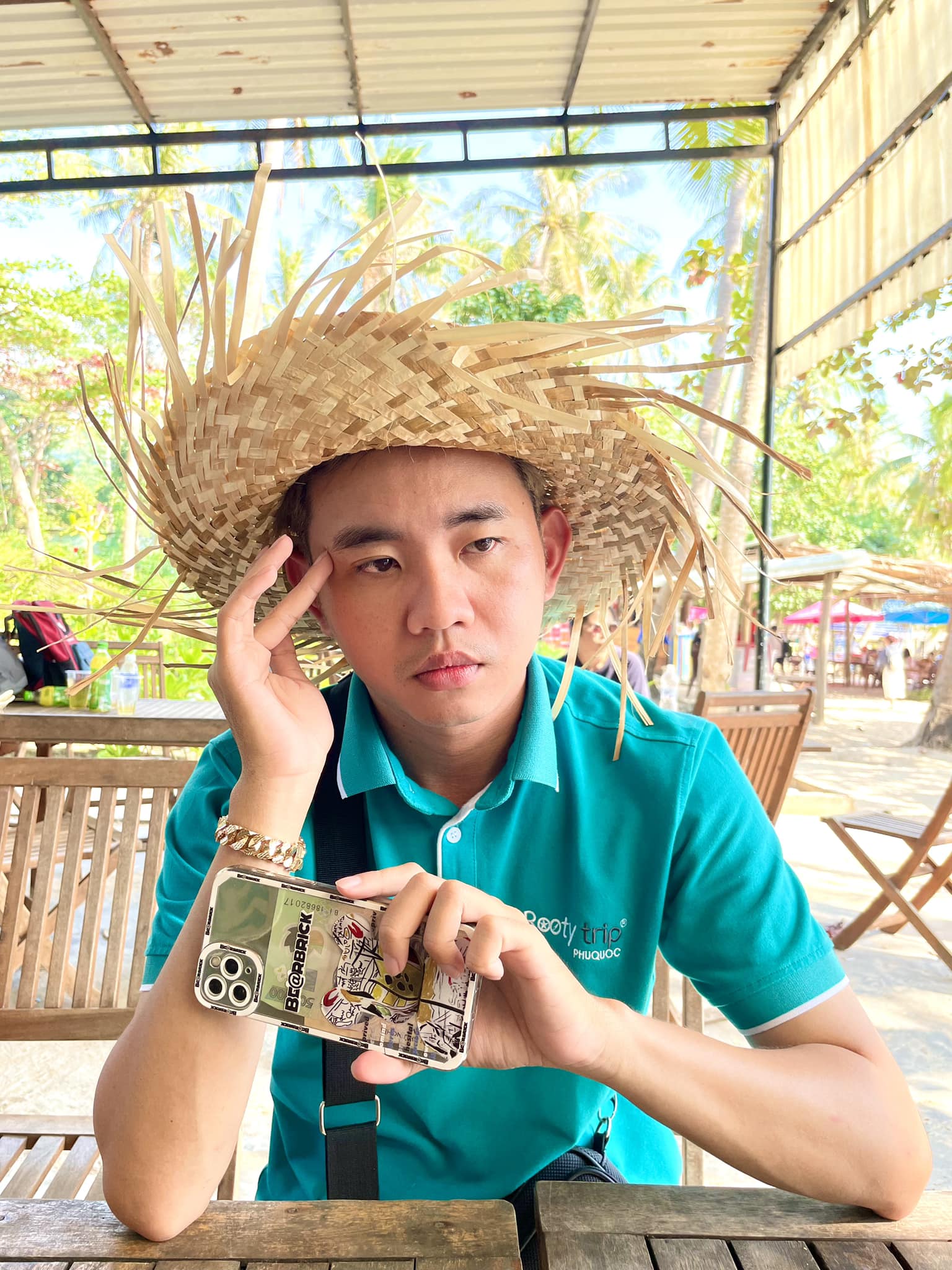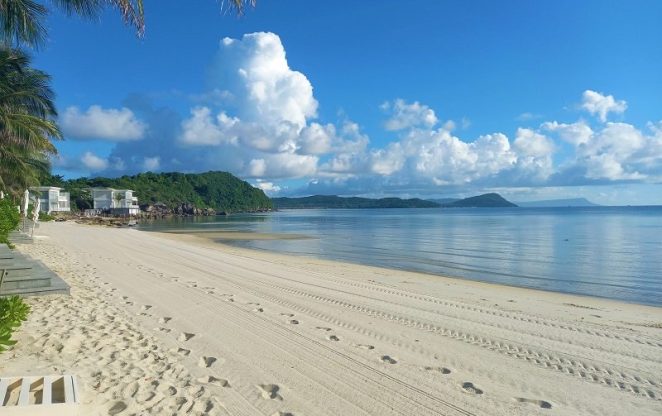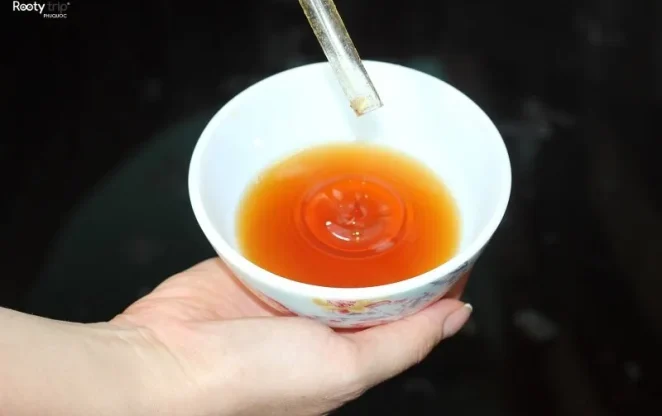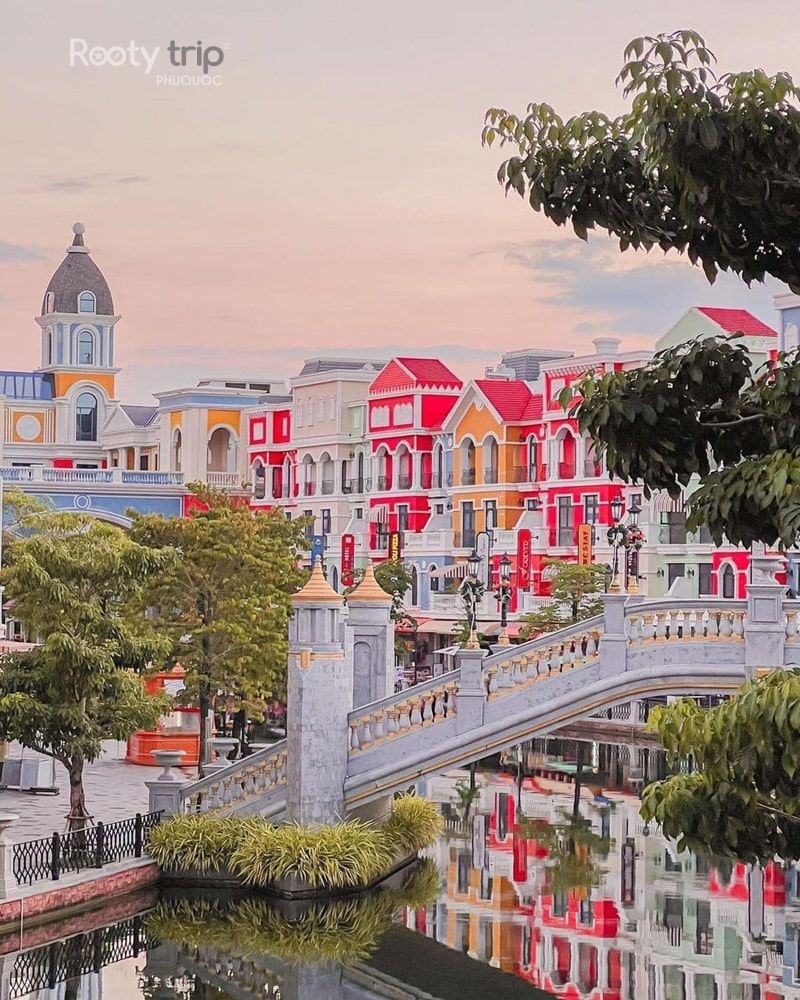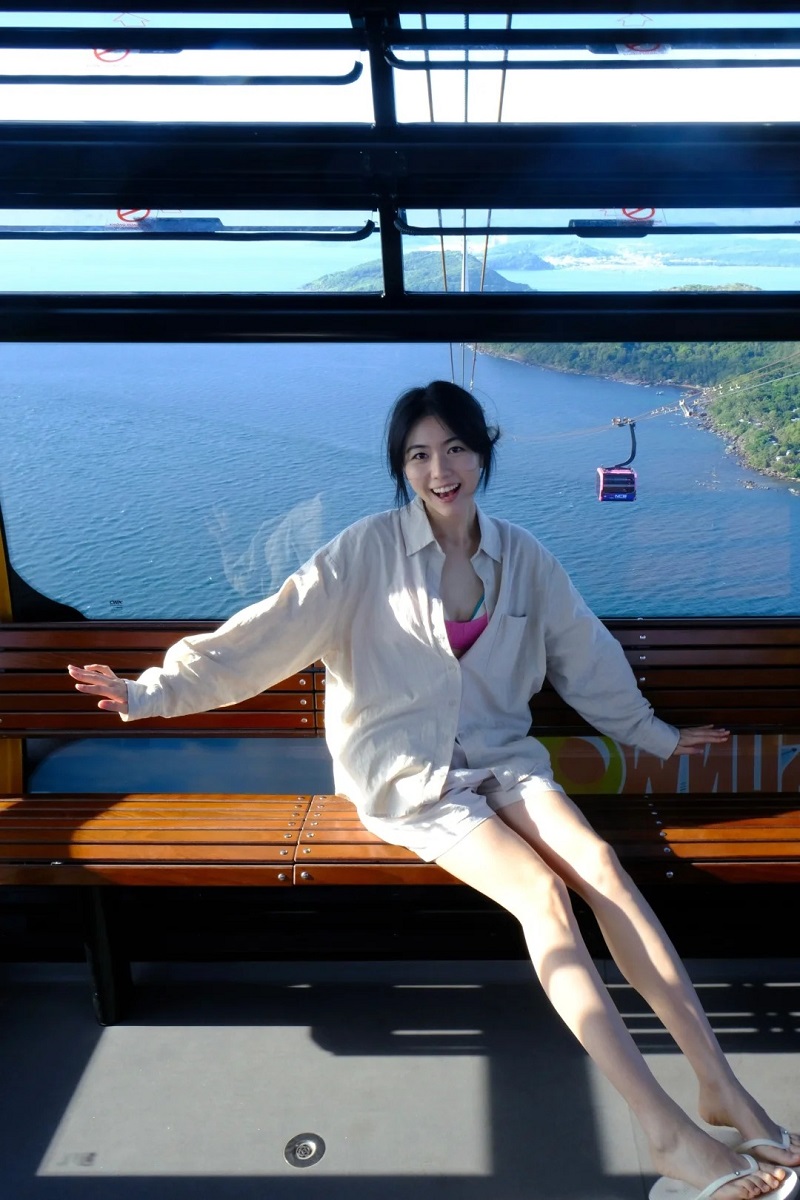Phu Quoc Prison – A Guide to the Historic War Camp
What To Do In Phu Quoc
Phu Quoc Prison stands as a stark reminder of Vietnam’s tumultuous past. During both the French colonial era and the Vietnam War, it served as a site of immense suffering and brutality. Today, the prison has been transformed into a museum and memorial, offering visitors a glimpse into the nation’s resilience and the horrors of war.
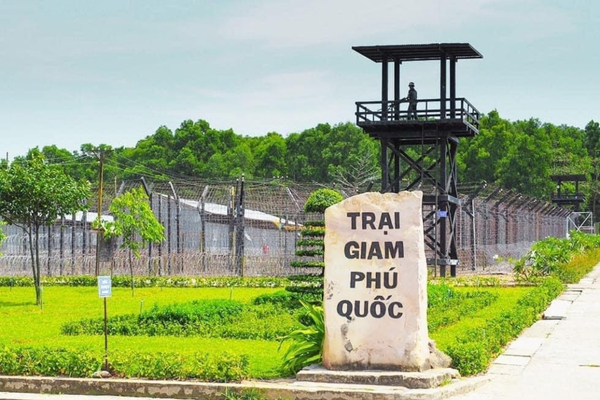
Phu Quoc Prison – Where the glorious history of the nation is preserved
Introduction to Phu Quoc Prison
Phu Quoc Prison, also known as Phu Quoc POW Camp (An Thoi POW Camp in English), is a historical site located on Phu Quoc Island in Kien Giang Province, Vietnam. During the First Indochina War (1946-1954), the prison was known as Cay Dua Prison (Coconut Tree Prison). Built in 1946, this prison once held 40,000 prisoners, including many staunch revolutionaries.
The relic site covers an area of over 40 hectares, including areas such as detention areas, torture areas, underground tunnels, a memorial house, and many valuable historical artifacts.
In 1995, Phu Quoc Prison was recognized as a National Relic Site by the Ministry of Culture – Information. The Phu Quoc Prison Museum currently houses thousands of artifacts, images, and videos depicting the harsh prison life and the heroic sacrifices of the revolutionary fighters.
Where is Phu Quoc Prison?
Phu Quoc Prison is located at 350 Nguyen Van Cu Street, An Thoi Ward, Phu Quoc, Kien Giang. Phu Quoc Prison is about 29 km south of the center of Duong Dong town, which is equivalent to a 40-minute drive.
Opening hours:
- Monday to Saturday: 7:30 AM – 11:30 AM and 1:30 PM – 4:30 PM
- Sunday: 7:30 AM – 11:30 AM
Entrance fee: Free
Getting to Phu Quoc Prison
There are 3 main means of transportation from Duong Dong center to Phu Quoc Prison:
- Motorbike
The route you can follow:
- Start from Duong Dong town and go south on Tran Hung Dao Street.
- Turn left onto Nguyen Van Cu Street.
- Go straight for about 25 km, Phu Quoc Prison will be on your right hand side.
Notes:
- Be careful, pay attention to traffic safety and obey traffic rules.
- Bring with you full identification papers and necessary items.
- It is recommended to fill up the gas tank before going because the distance is quite far.
- Bring sunscreen, hats, and water as the weather in Phu Quoc is quite hot.
- It is recommended to go in a group to support each other in case of an accident.
- Taxi
You can easily catch a taxi on the street or call a taxi through reputable taxi companies such as Mai Linh, Vinasun,… The taxi fare from Duong Dong center to Phu Quoc Prison ranges from 150,000 VND to 200,000 VND. It is recommended to negotiate the price before getting in the car to avoid being overcharged.
Maintain public hygiene and do not litter in the car.
- Bus
You can take bus number 10 from Duong Dong center to Phu Quoc Prison. The bus fare is 15,000 VND/trip. However, the bus only runs at certain times of the day, so you need to be aware of the travel time.
Exploring the History of Phu Quoc Prison
Phu Quoc Prison has witnessed the fierce battles of both the anti-French and anti-American resistance wars, aimed at protecting the independence of the Vietnamese nation. To make your visit to Phu Quoc Prison more complete, you can learn about the history of this place beforehand to better understand and prepare mentally when visiting.
Phu Quoc Prison under French Colonialism
After occupying Phu Quoc in 1946, the French decided to build the largest prison in Southeast Asia to detain revolutionary fighters. During the anti-French resistance war, General Hoang Kiet, under the control of the French colonialists, led more than 30,000 Kuomintang troops to flee to Vietnam and station themselves in Phu Quoc.
After they left in 1953, the French used the Kuomintang barracks as a prison to detain over 14,000 prisoners of war. The name Cay Dua Prison also began to appear from here. Cay Dua Camp, one of the largest and most brutal prisons built by the French colonialists during the Vietnam War.
In 1952, the jailbreak of 200 prisoners was directed by the Party Committee Standing Committee with the aim of organizing the liberation of a large revolutionary force. Although the result was unsuccessful, the riot at Ben Dam “was an attack on the enemy’s lair, shaking their domination.”
In July 1954, under the Geneva Accords, France was forced to return most of the prisoners of war at Cay Dua Camp to the Democratic Republic of Vietnam. Cay Dua Camp became a symbol of the steadfast will and indomitable spirit of our army and people in the war against France.
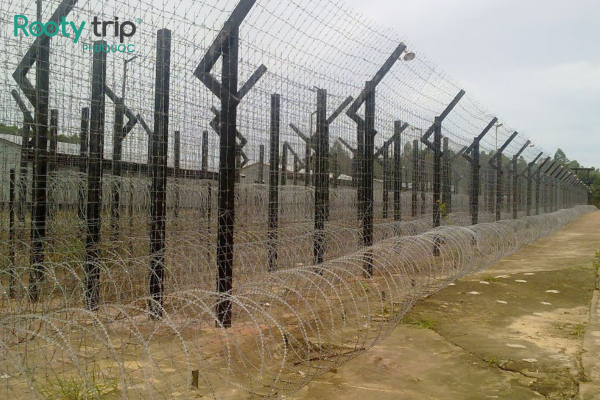
Phu Quoc Prison is surrounded by barbed wire fences.
Phu Quoc Prison under the US-Puppet Regime
At the end of 1955, the Republic of Vietnam built Cay Dua Central Training Camp at the old Cay Dua Camp in Phu Quoc with a total area of 4 hectares, including male, female, and elderly prisons.
On January 2, 1956, 598 prisoners from the Bien Hoa Central Training Camp were transferred to Gia Dinh, then brought to Phu Quoc on the navy’s Black Giang ship from Saigon.
From February to September 1956, in just 7 months, there were about 100 prisoners who escaped and some were shot dead while trying to escape from the prison camp.
After 1957, the Republic of Vietnam authorities made some changes to the prisoners at Cay Dua Camp. Some political prisoners were transferred to the mainland, while others were exiled to Con Dao prison.
In 1966, the US-puppet regime built the Phu Quoc Communist Prisoner of War Camp, which is more than 400 hectares wide, in An Thoi Valley, 2 km from the old “Cay Dua Camp”. This is considered the earthly hell of all those who were exiled here.
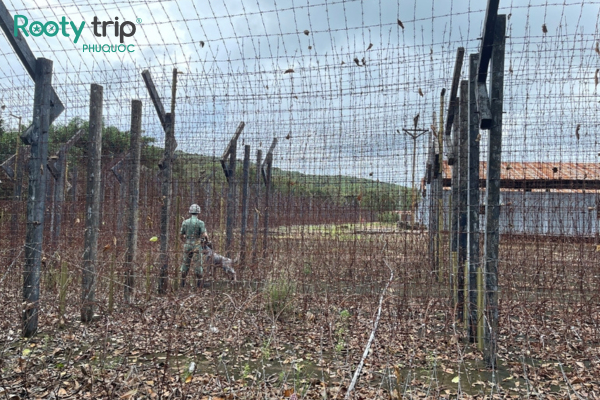
Phu Quoc Prison bears the marks of a devastating war
7 Most Memorable Locations at Phu Quoc Prison
Inside the prison are exhibition rooms, housing valuable artifacts, images, and documents that recreate the harsh lives and indomitable spirit of communist prisoners of war during the war. Here are 7 prominent places that are mentioned and visitors can consider visiting:
Gate of the 8th Military Police Battalion
The gate of the 8th Military Police Battalion is the main entrance to the 8th Military Police Battalion, which guards and controls Phu Quoc Prison Camp. The gate is built in a classical French architectural style with 2 square pillars made of solid bricks and an iron core. The special feature is the curved arched roof, creating a majestic and imposing appearance. The gate is surrounded by barbed wire fences, reminiscent of the past guard duty.

Gate of the 8th, Phu Quoc Prison.
Prisoner of War Cemetery
The prisoner of war cemetery has an area of about 20,000m², located on Hill 100, about 1km from the prison camp, section B2. Since 1975, it has been built with reinforced concrete and has a fence surrounding it. The cemetery is the final resting place of more than 3,000 communist prisoners of war who died in Phu Quoc Prison.
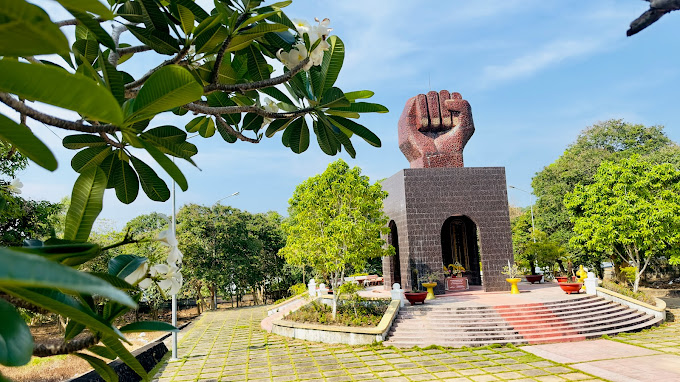
Phu Quoc Prisoner Cemetery (Photo: Long Tam Pharmacy Phu Quoc)
Kien Van Church
Kien Van Church, with an area of over 4000m², was built in 1968 by prisoners of war, using cement, wood, steel and other materials available in the prison. The architecture of the church is simple but very impressive, with a high roof, large windows and white walls.
Kien Van Church is not only a place of worship and prayer for prisoners of war, but also a center for cultural, educational and spiritual activities.
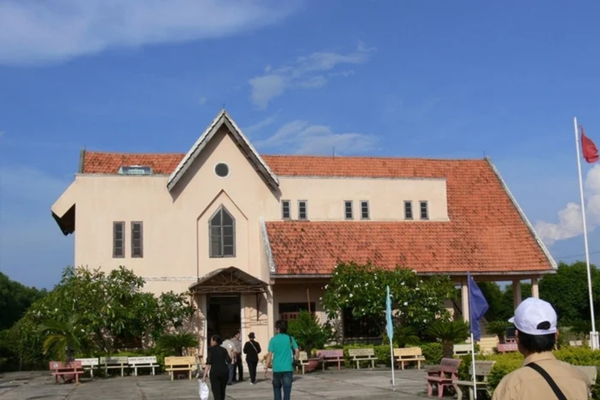
Explore Kien Van Church, Phu Quoc.
Additional Relic Exhibition House
The exhibition house has a spacious exhibition space with an area of about 200m², divided into two rooms.
Room 1 displays artifacts and the history of the formation and existence of the prison.
Room 2 displays over 100 documentary photos depicting the enemy’s torture as well as the bravery and steadfastness of our ancestors during the arduous war period.
With its modern architecture harmoniously combined with traditional details, it has honored the historical value of the relic. The special feature is the use of advanced technologies such as touch screens, virtual reality, etc. to increase interaction and experience for visitors. Through that, visitors also have the opportunity to explore new perspectives and the mysterious stories behind this relic.
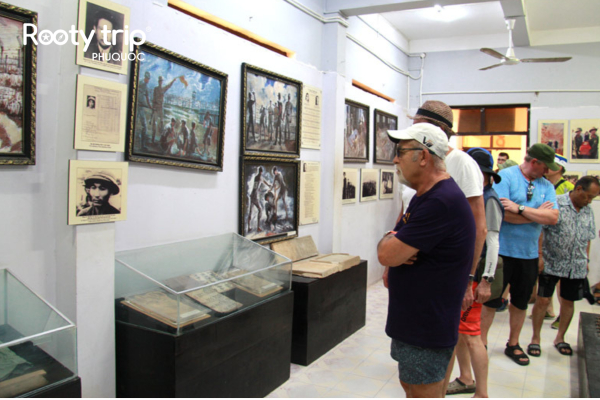
Exhibition house supplements the relics depicting brutal enemy torture images.
Section B2
Section B2 in Phu Quoc Prison, with an area of over 17,000m², is currently being restored. This area includes many items such as watchtowers (guard posts), fences, the gate of Section B2 prison camp, barbed wire tiger cages, kitchens, dining rooms, detention areas and torture chambers…
When entering Section B2, visitors seem to be turned back in time, to the years of fierce war. This place evokes in visitors feelings of emotion, pity and gratitude for those who sacrificed their lives for the independence and freedom of the nation, and at the same time helps visitors better understand the silent sacrifices and indomitable spirit of the Vietnamese people.
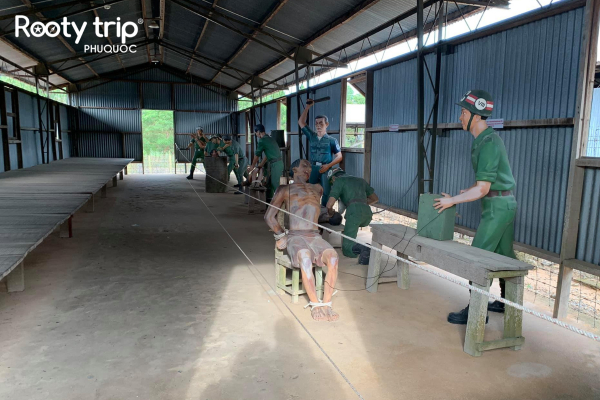
This scene that always appear in the torture area of Phu Quoc Prison
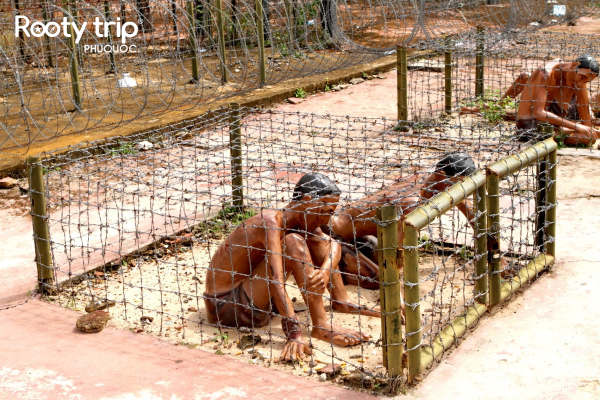
Barbed wire tiger cages – just need prisoners to move or change positions to be stabbed by barbed wire into their bodies
Martyrs’ Monument at Sim Hill
Located on an area of 12,420.5m², the Martyrs’ Monument at Sim Hill impresses with its unique architecture. The Martyrs’ Monument is designed with two 5m high waves on either side, and in the middle is a sharp block hollowed out inside for about 2m, meaning “the people who came out of that place” symbolizing the steadfast and indomitable will of the Vietnamese people.
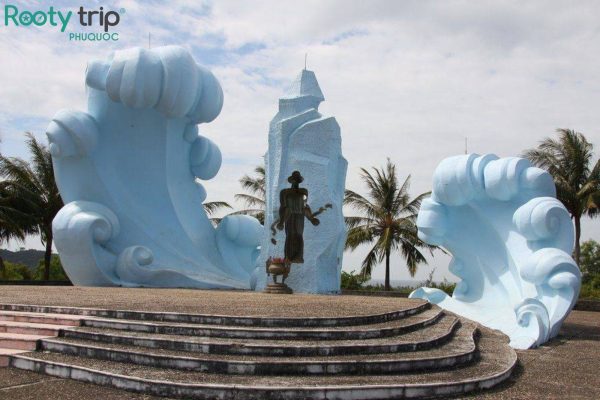
Martyrs’ Monument at Sim Hill
Gate and Command House of the Prison Camp
The gate and the command house of the prison camp are currently being restored with reinforced concrete, a corrugated iron roof and wooden windows. The front door is built with strategic iron bars and barbed wire. This work is simple but has many historical marks, recreating a part of Phu Quoc Prison – the most brutal prison and torture camp in Vietnamese history.
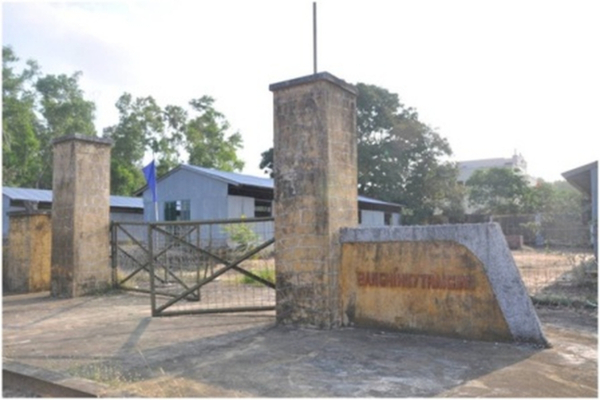
Gate and Command House of Phu Quoc Prison before renovation
Below are some additional images collected by Rooty Trip about Phu Quoc Prison. You can refer to it to learn more about the suffering that this place has experienced during these bloody wars.
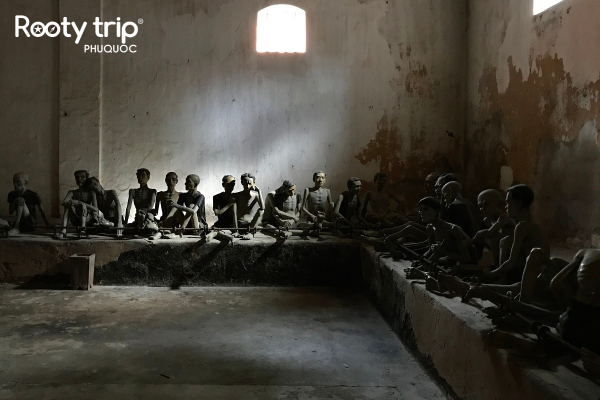
Prisoners are detained en masse at Phu Quoc Prison.

Prisoners are tortured to the extreme, with no life left.
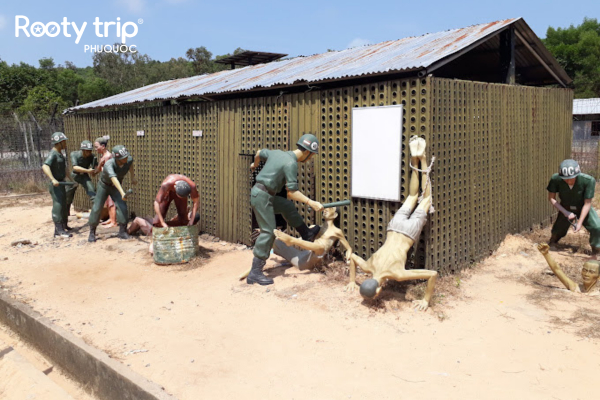
Inhuman punishments.
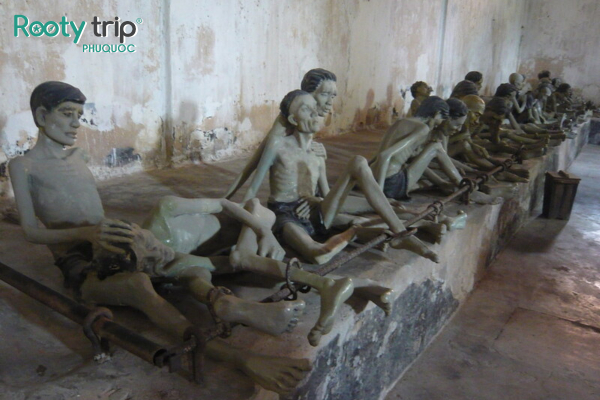
Phu Quoc Prison – where patriotism can overcome all hardships.
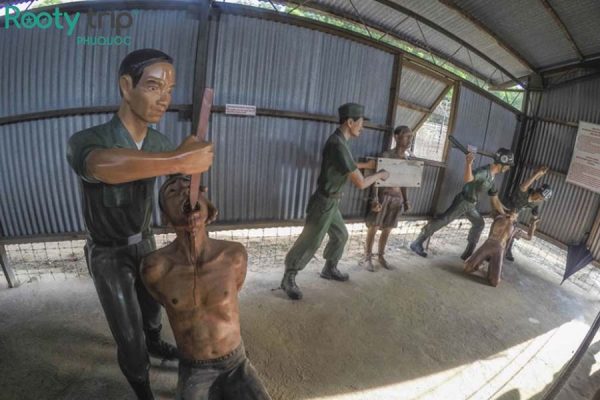
Brutal tooth extraction torture.
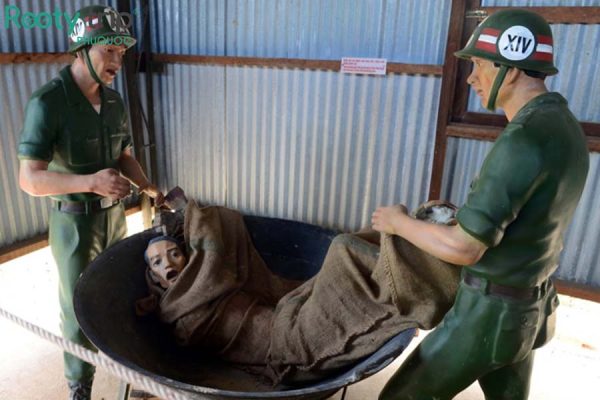
Prisoners subjected to ‘boiling oil pot’ torture.

Burning the genitals of prisoners to eradicate reproduction.
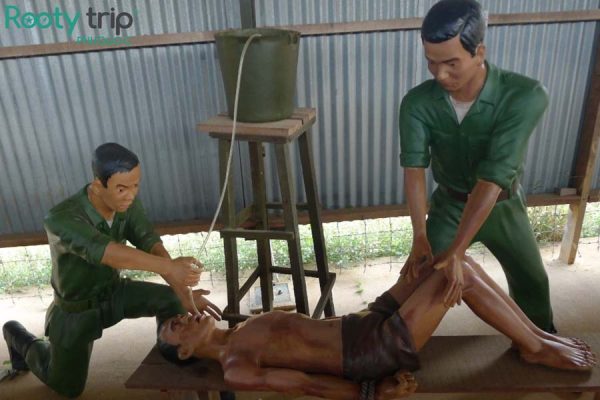
Brutal guards torture prisoners.
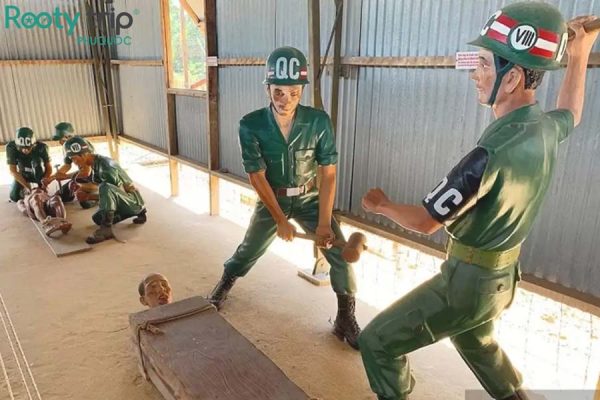
‘Body pressing’ torture method.

Nailing into the bodies of prisoners.
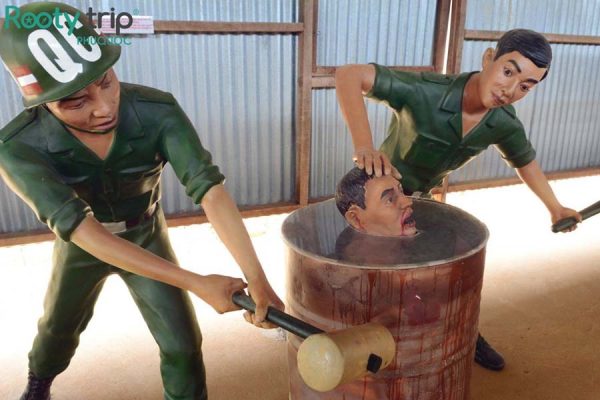
There are always terrifying punishments at Phu Quoc Prison.
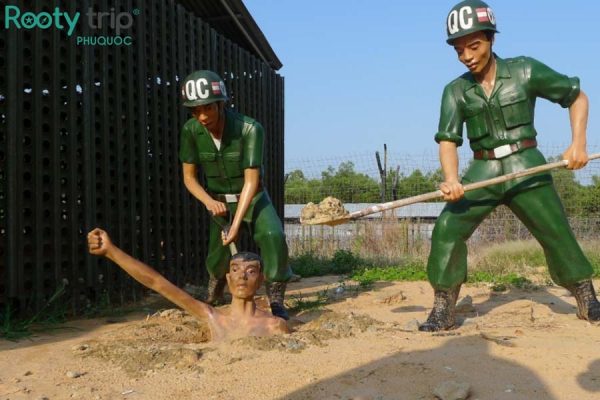
Spirit of resilience, indomitable even in the face of impending death.
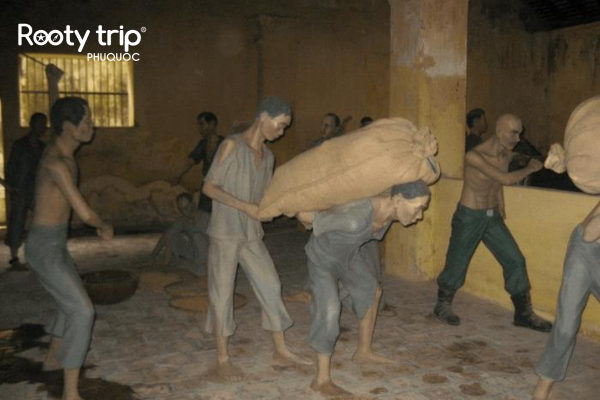
Not only tortured, prisoners are also brutally exploited.
Should you explore Phu Quoc Prison on my own or with a guided tour?
The choice between self-exploration and a guided tour at Phu Quoc Prison Camp depends on your preferences and needs.
Self-exploration allows you to be flexible with your time and spend more time in the areas that interest you. However, you will need to research the information about each section yourself, which can be quite time-consuming and laborious.
Booking a guided tour saves you time and effort in researching information. The guide will provide you with detailed information about the history of the prison, as well as fascinating historical stories. In addition, tours often combine visits to the prison and other places, saving you transportation costs and making it easier to arrange your itinerary.
Let Rooty Trip accompany you. If you are looking for a tour package that includes a visit to Phu Quoc Prison, you can refer to Rooty Trip’s South Phu Quoc Island tour with the following information:
- Visit the main areas of the prison such as area A, area B, area C, solitary confinement area, exhibition house, memorial area…
- Have a guide who is knowledgeable about the history of Phu Quoc Prison explain each area in detail.
- Pick-up and drop-off service, no need to worry about transportation. There will also be delicious meals, ensuring food safety and hygiene.
- Take professional photos and videos with flycam, free of charge at tourist attractions.
- All-inclusive service including airfare, hotel, meals, sightseeing…
With over 6 years of development and operation in the industry, experienced, enthusiastic and dedicated tour guides. In particular, Rooty Trip serves more than 7,500 customers each month and has more than 1,000 reviews with 4.9/5 stars on the fanpage. More than that, Rooty Trip is honored to be a partner of more than 100 3-5 star hotels and resorts in Phu Quoc.

Rooty Trip is chosen by many customers to have memorable trips in Phu Quoc
Other destinations near Phu Quoc Prison
Here are 7 tourist destinations near the prison that many visitors visit when they come to Phu Quoc:
- Sao Beach (4.5km away): The most beautiful beach in Phu Quoc with fine white sand, turquoise water and many fun activities.
- Khem Beach (7km away): A pristine beach with long stretches of white sand, clear blue water and rows of shady coconut trees.
- Hon Thom Island (12km away): The largest island in the An Thoi archipelago with many fun activities such as cable car, diving, visiting the zoo…
- Tranh Stream (8km away): An eco-tourism area with a cool stream, majestic waterfalls and wild natural scenery.
- Phu Quoc Pepper Garden (6km away): Where visitors can learn about the pepper growing process and buy high-quality pepper products.
- Ham Ninh Fishing Village (10km away): A traditional fishing village with unique stilt houses and many experiential activities such as night squid fishing, coral reef diving…
- Phu Quoc Fish Sauce Factory (12km away): Where visitors can learn about the traditional fish sauce making process and buy high-quality fish sauce products.
I hope this article will help visitors gain more experience in visiting Phu Quoc Prison and how to enjoy the most complete trip. Rooty trip, a reliable companion to help you experience the full beauty of Phu Quoc!
ROOTY TRIP PHU QUOC
Address: 191 Tran Hung Dao Street, Cua Lap Hamlet, Duong To Commune, Phu Quoc Island, Kien Giang
Phone/Whatsapp: 0886.068.886 – 033.906.2222
Email: cskh@rootytrip.com
Fanpage: https://www.facebook.com/rootytripphuquoc/
Instagram: https://www.instagram.com/rootytrip/
Comment
Leave comments & reviews
Login to comment & rate





